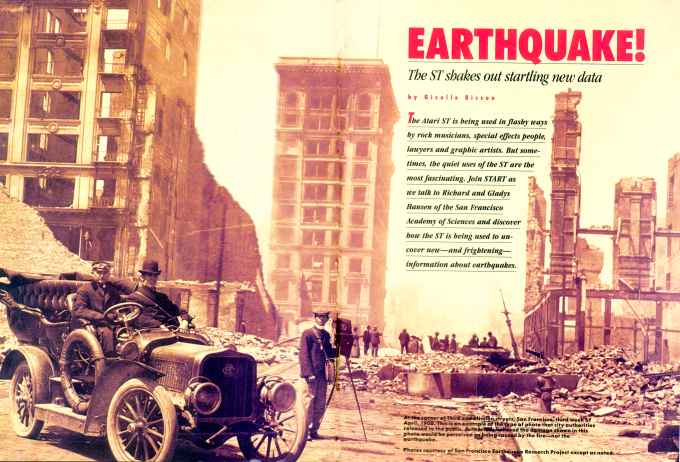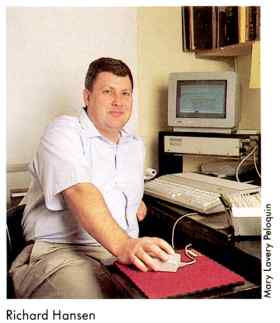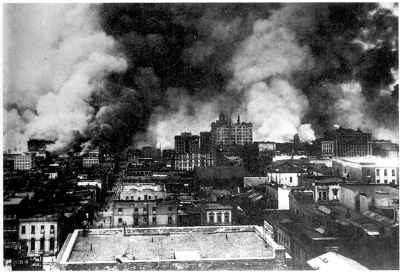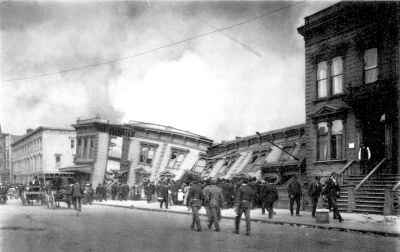
At the corner of Third and Mission streets, San Francisco, third week of April, 1906. This is an example of the type of photo that
city authorities released to the public. Authorities believed the damage shown in this photo would be percieved as being caused by
the fire-not the earthquake.
Photos courtesy of San Francisco Earthquake Research Project except as noted.
EARTHQUAKE!
The ST shakes out startling new data
by Giselle Bisson
The Atari ST is being used in flashy ways by rock musicians, special effects people, lawyers and graphic artists. But sometimes, the quiet uses of the ST are the most fascinating. Join START as we talk to Richard and Gladys Hansen of the San Francisco Academy of Sciences and discover how the ST is being used to uncover new-and frightening- information about earthquakes.
Until I met Gladys and Richard Hansen, I thought fire was responsible for most of the damage done in the 1906 San Francisco earthquake. And until very recently, so did most of the scientific establishment. But all of that is going to change soon as the Hansens completely rewrite the history of earthquake knowledge-with the help of Atari STs.
"We're shocking the professional earthquake world," Richard says as we sit in the spare bedroom he uses as an office. A 3-by-5 card file reaches from floor to ceiling, and stacks of paper, books and box after box of paper file folders line the walls. "Everything in that card file and most of what's in the room is also in here," he says, pointing to the Atari 20-megabyte hard disk drive on his desk.
Imagine searching through all that paper to find, say, every comment about every house that burned in a particular neighborhood. Try flipping through cards to narrow that down to every brick house, and you get an idea of how a personal computer can speed things up.
With the help of Atari ST computers, Hansen and the other members of the San Francisco Earthquake Research Project are rewriting the history of San Francisco's great 1906 earthquake. (A "great" quake is classified as one with a Richter number of 8 or more, and one that spreads the "shaking" over a very large area. For example, Mexico City was devastated in 1985 by an 8.1 Richter quake whose source was 250 miles away.) Their conclusion is indeed startling: city officials and business owners deliberately covered up the damage because they feared the awful truth would prevent them from getting the money needed to rebuild a devastated city.
The Earthquake Research Group consists of four volunteers: Hansen, a former fire department photographer who, since 1970, has given presentations about earthquakes; the project's director (and Richard's mother), Gladys Hansen, the city archivist and author of The San Francisco Almanac; David Fowler, a former news anchor and an advisor at the Federal Emergency Management Association (FEMA) in Maryland; and San Francisco Fire Department Chief Emmet Condon. The members have put countless hours and about $10,000 of their own money into the project.

FROM CARD FILE TO DISK FILE
This massive research project just couldn't be done without the help
of a computer database to sort and tabulate the 35,000 records and personal
narratives the researchers have accumulated. Each fact about or reference
to a disaster is cross-referenced by street address and name and then keyed
to the source material. And this is only the tip of an enormous and fascinating
historical iceberg.
It all started rather innocently as a genealogy project 20 years ago. People kept badgering Gladys at the library and asking, "Did my relatives die in the great earthquake?" Using eyewitness reports, letters, diaries, historical documents and coroner's records, she filed the information on 3-by-5 index cards.
"It started to be a great machine, just the card file alone, giving us answers to a lot of questions that have always bothered historians," she says.
The official death toll set by the SF Board
of Supervisors in 1907 was 478. After accounting for different
spellings in newspapers, Gladys found that there were really 800 deaths.
Gladys then started a national letter search to genealogy societies asking
for personal letters. When the death toll climbed to over 1,000, she knew
she was on to something big, but she wasn't sure what.
Her son Richard got interested when he noticed that many of the historical photos were heavily retouched to disguise the earthquake damage. Fowler, a San Francisco broadcast reporter who had done a few news stories about Gladys, volunteered to enter the information about the deaths into his Apple IIe computer.
One day, Fowler called Richard about midnight. "Guess what?" he said. "It looks like a pattern." According to Richard, "We went further and entered the injured, too. We drew our own map of the firm land just by dead and injured alone. Then we realized that some parts of the city didn't correspond with what is accepted today as firm and infirm ." They discovered what later became clear: somebody had intentionally covered up the deaths.
"The government considers anyone in a fire who dies up to one year later a fire casualty, because burns often don't kill until much later So we called some of the great names in seismology and asked, 'What is an earthquake death?' They came to the conclusion that an earthquake casualty includes those who died up to a year later. The toll climbed again.
"The funny thing that always kinda stuck as a thorn in people's sides is, well, some of the narratives are so horrible, but today's books make it sound like a fun thing, you know, 'Go down and watch another block burn,'" says Richard.
Currently, all earthquake projections are based on a book called the NOAA (National Oceanographic and Atmospheric Administration) Report, which is used as the "disaster bible" by fire departments and emergency planning agencies. Look up a city block in the book, and it tells you what kind of injuries-and deaths-to expect. "Now the guys who wrote that are on our advisory board," Richard says, "and we're completely changing the report."
When the deaths were plotted according to location and analyzed in a database, a pattern emerged, creating a new map of destruction. Many areas of the city previously thought to be firm were actually devastated. Over 80 years later, in 1988, the consequences of the Hansens' research will shake up San Francisco again.

An example of a photo retouched to hide earthquake
damage. Buildings with
collapsed walls have been painted over to appear intact.
Each insurance case, narrative or photo had to be cataloged on a different file within the database and keyed with information so it could be cross-referenced. Luckily for the Hansens, Richard Frick, Atari's Director of Software, found out about the group and graciously arranged for Atari to donate five 1040 ST computers, five 20-megabyte hard disk drives and copies of Datatrieve, a database from Abacus Software. The group even convinced Abacus to modify Datatrieve to allow more record entries.
The computers have been the only donation so far "The 3-by-5 cards almost bankrupted us," Richard said, "and we still can't afford photocopies at the National Archive at 30 cents a page.
are rewriting
the history of
San Francisco's great
1906 earthquake.
"We collated earthquake information from every conceivable source and discovered that nobody has cross-referenced this information before," Richard says. "Once it was in the ST, we discovered our original conclusions were wrong." They were able to debunk the myths that most people died in fires and that building standards at the turn of the century were less stringent than today. "But the best thing about the ST computer is that it forces you to be organized," Richard said.
WE'RE NOT READY
Richard and I went to his basement, which the Hansens have transformed
into a neighborhood disaster preparedness center Here, another 1040 ST
records historical photos with a video camera and digitizer There are Ham
radios, cameras, a fully stocked darkroom and, not surprisingly, a cache
of canned foods and earthquake rations lining an entire wall. Richard has
also completely reinforced the foundation of the house.
Over the past two years, scientists and seismologists have trekked to the door of the Hansens' quiet house out near San Francisco's Ocean Beach. Now the project's official headquarters have moved a few miles away to the California Academy of Sciences. Producers from the PBS television series NOVA are preparing storyboards for an episode on the group's research that will be broadcast next September, and the project has also attracted the attention of Smithsonian magazine. In addition, the group has written an illustrated book on the earthquake, recently released by Cameron and Company Publishing. This collection of narratives and photos also was compiled with the help of the Atari ST.
Because of the group's findings, building codes, standards and insurance rates (perhaps even real estate values) will have to change. But most important, Richard stresses, so must earthquake preparedness measures (and expectations) in San Francisco and the rest of the world.

Golden Gate Avenu, near Hyde Street, San Francisco.
An example of buildings
that had been built on infirm (swampy) ground. When
the 1906 earthquake hit,
swampy ground turned into liquid-a suspension of dirt
and sand in water.
The job's not over yet. "We have at least 20 years worth of research left to do," Richard says. "We want to visit every historical archive in the West. We also want to find people who left the West with Kodak pocket cameras. Businesses paid over $1,500 in 1906 dollars to buy up photos of damaged buildings, and we want those photos." Incredibly enough, some of those people who sold photos bought new houses with the money.
DEBUNKING THE MYTHS
"San Francisco glows as a huge furnace," reported the Oakland Herald
on April 10, 1906. "From the hills behind Oakland, San Francisco provides
an awful, indescribable spectacle. By day, beyond the glimmering bay, there
rose a dreadful pall of smoke. As darkness fell, the fires glowed into
sight like a large row of open furnaces. Night turned the cloud into a
pillar of fire that rose miles high and miles wide."
From today's perspective, the 1906 San Francisco quake is especially important because, to date, it's still the only major quake to occur within a relatively modern city- one with telephones. telegraph lines, newspapers and the like. It's also different from the recent Mexico City quake because so many of San Francisco's buildings affected by the quake are still standing, available for study. Based on the Hansens' research, NOAA will have to change the "official' death toll of 500 to over 3,000. That will also change the projections for a future San Francisco earthquake from the current estimate of 11,000 deaths in the entire Bay Area to as high as 60,000. "I know a similar quake will occur someday," Richard says.
When Richard and Gladys talk about earthquakes, there is a sense of impending doom in the conversation. When they talk about the coming "Big One," it's tempting to dismiss them, much as you might dismiss UFO disciples or reincarnation proponents. But they talk as if they know something we don't. They do.
"A lot of the facts we unearthed really scare us," Richard says. For instance, it seems earthquakes are bad for business. They discourage investment from outside the city. So powerful businesses covered up the damage by dynamiting buildings, burning them down and destroying or retouching photographs. "We have buildings we call 'magic buildings.' Historically, these were earthquake survivors where 'nasty fire gouges' did the damage," Richard adds. "But when we added narratives to the database, we found, hey, in this guy's narrative, that building is wrecked!"
The researchers have also debunked the old "brick is more dangerous than wood" myth. According to their findings culled from the database, no more than 10 percent of the deaths occurred in brick buildings. Brick crumbles sooner than wooden buildings. but brick crumbles more evenly, and with fewer injuries. "My boss, Emmet Condon at the fire department, finds this hard to take. Richard says. The research team also theorizes that buildings designed in accordance with today's standards are actually much weaker than those designed immediately after 1906.
PANDORA'S BOX
The research group has opened up a Pandora's box of historical controversy
"We're seeing the doors open, but we can't trot into every door," Richard
says, although he rattles off the secrets behind some of the doors. "Buildings
insured in 1906 were fraudulently collected on. The damage was felt over
a much larger area than people think. We've found disturbing evidence of
racial discrimination in relief efforts. Property owners launched a massive
campaign to buy up photos of damaged buildings. Police even tried to steal
a hose from the Fire Department."
The political scandal and ethical questions are overshadowed by the immediate reality that San Francisco. like most other cities, is drastically unprepared for another earthquake of that magnitude. "The standards for firm and infirm ground must be changed, electrical damage to cables and vaults, computer lines . . . It's gonna go," Richard says emotionally clenching his fists.
"Or what if the Big One came and people mistakenly thought it was a bomb?" he asks rhetorically. Prior to 1900, earthquakes were thought to be "air quakes" because of their deafening sound. Through eyewitness accounts, the group learned that the sound of the 1906 earthquake, believed to register 8.7 on the Richter scale, was far louder then ever previously believed. In one account, a man watched a building being dynamited two blocks away, but could not hear the explosion over the deafening roar of the earthquake.
"In not a single account was anybody standing," Richard says. "That's scary." Some of the narratives he describes are horrifying tales of apocalyptic destruction. Terrified people were knocked to the ground. clutching the pavement as the streets buckled and the earth undulated violently. in many cases, people all over the Bay Area were knocked down with such force that they suffered broken fingers, wrists, ankles, arms and legs.
"The citizens deserve to know," Richard says. "If we have another quake of 1906 magnitude, the sound will be deafening and there will be damage to the entire region, from above Eureka to below San Jose. Nobody will stand." Gladys's accounts also show a city tormented by arson, dynamiting, a military going wild under eminent domain, and looting in the San Francisco mint. "Military installations were a mess, too. If you wanted to attack the coast, that was a good opportunity" Richard adds.
Richard's comment brings up another interesting point. In 1906. 10 percent of the United States' military personnel were stationed in the Bay Area. Buildings collapsed as far east as the Sierra Nevada mountains, and telegraph lines were out as far as Utah. Amazingly enough, Washington found out about the quake from an uncoded military cable sent out over the Pacific, out to Hawaii, then past Japan and the Far East until it reached Europe and was routed to the nation's capital. Since Japan had attacked Russia with impunity just the year before, Washington officials panicked that the cable would be an enticing invitation for the Japanese to attack a devastated West Coast. A cable came back-again, going completely around the globe-and advised the Presidio Army Base that there was no military damage."
THE STORY TODAY
In January 1987, the research group members were appointed Associates
in Seismology at the California Academy of Sciences. "As a team, these
individuals have compiled extraordinary files on the 1906 earthquake, files
that will have a significant impact on the ultimate interpretation of that
disaster," said Dr Peter Rodda, Chairman of the Academy's Department of
Invertebrate Zoology and Geology "The research will not only cause history
books to be rewritten, but will be of inestimable value to seismologists,
engineers and city planners," he said.
HOW YOU CAN HELP
For 20 years, Gladys Hansen has pieced together the earthquake puzzle
with the help of people who had family in San Francisco at the time and
offered diaries, letters and news clippings. Of particular help are photographs
taken by survivors that document damage. "Even a picture of a home with
a missing chimney provides valuable information," she says. All materials
will be duplicated and returned.
If you can help with photos, accounts or donations of Atari ST software or hardware, please write to: San Francisco Earthquake Research Project, California Academy of Sciences, Golden Gate Park, San Francisco, CA 94118.
If you'd like to see more articles like this, circle 152 on the Reader Service Card.
Giselle Bisson is a San Francisco freelance writer. Her articles have also appeared in Antic and Model Shopper.
PRODUCTS MENTIONED
-
Datatrieve, $49.95. Abacus Software, P.O. Box 7219, Grand Rapids, MI 49510,
(616) 241-5510.
CIRCLE 153 ON READER SERVICE CARD